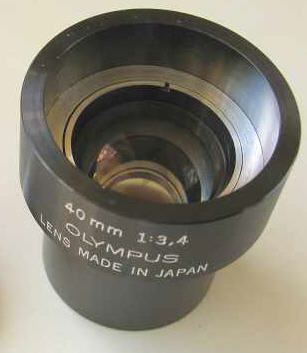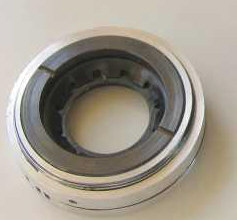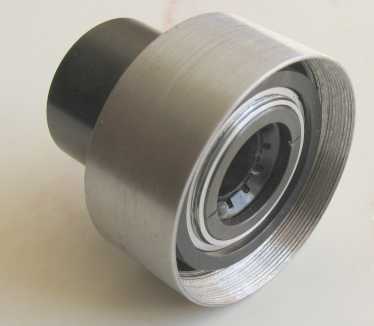| The Poorman's
Photomacroscope (pt7)
Installing a High Quality Low Cost Imaging Objective By Paul James |
I've recently acquired an interesting optic from eBay which has proved to be a very competent imager in the photomacroscope : An Olympus 40mm f 3.4 document copying camera's objective which was clearly unused and in mint condition : several of which have already been sold for around £6-8. Providing a little more magnification and resolution than the standard film camera lens, it actually performs very well within the infinity or non infinity configuration. Colour aberrations are minimal, the field is flat too, and the image bitingly sharp in darkfield, which isn't surprising given that it was originally designed for imaging documents where it apparently was raising an image resolution of around 250 lpm. Of course that figure might actually equate to 125 lppm ( line pairs per millimetre ) which is a moot point since its actual imaging prowess in the macroscope is very impressive.
It is physically somewhat smaller than the average 50mm film camera lens, but the weight of its one piece alloy body hints at a lot of glass in its interior for a relatively modest f3.4 optic.
 |
| The original lens as received minus
an
unnecessary retaining ring in preparation for the installation of an iris diaphragm |
My assumption that the 'front' element was the larger one reinforced by the fact that the legend was also at that end, led me to think of a way to mount it in the preferred reversed mode, which very conveniently made for a simple technique by virtue of its circular lip/shoulder around the lens body. Supporting the lens was therefore resolved by making a simple coupling device which had been originally an old bearing dust cover cup I'd sourced from scrap. All that was required in adapting this oddment was to enlarge its original hole and cut the internal thread to fit the 49mm filter ring on the 'scope. So when the cup is screwed in place on the filter thread of the macroscope it automatically centers and holds fast the lens by nipping its circular shoulder captive.
First imaging trials were very promising, taking into account its fixed f3.4 aperture. Of course the amplification of the image was somewhat larger than with 50mm camera lenses, and its intrinsic resolution was noticeably superior too, though at the cost of reduction of the depth of field as I'd expected. Working distance was just adequate enough, at around 20mm or significantly more in the finite setup, which is about half that of the 50mm film camera lens, so still enabling enough clearance for compact lighting units to bathe the subject in full light.
I soon started to experiment with cardboard aperture stops to see if any subtle improvements in image quality/DOF could be gained. It did, and so having realised I had a very useful 40mm objective I began to look for a way of installing a proper iris diaphragm so I could conveniently alter its aperture relatively quickly and more gradually than with cardboard cut outs . But rebuilding the optics into a purpose made mounting would not be on my list of priorities as I needed to find out how the objective would behave with an iris before even considering a complex transplant of optics, so I'd start by installing a modified iris of suitable size into the circular recess above its front element.
 |
By severely trimming the mount of an old enlarging lens in various ways in the lathe, I was able to reduce the diameter of its basic iris unit to fit neatly into the front recess of the 40mm objective. Of course this wasn't the ideal position for an iris but it did effectively exclude the outer margins where the more errant rays carry most of the aberrations to the focal plane. In its new role of outputting a bundle of rays toward the eyepiece, vignetting, which would occur in normal terrestrial photography, would be effectively absent. At this present time of writing I have yet to devise a way of coupling the iris mechanism to the nose piece of the macroscope, so I can conveniently twist the outer body of the objective whilst observing its effects on the image. For now at least I can preset the iris before fitting the objective in anticipation of what is required concerning DOF when capturing images on the digital sensor.
 |
Concluding Thoughts
Having experienced the handling and imaging of this novel objective over a period of a few weeks now, I can confidently report that I am delighted with its imaging capabilities. Indeed I can't find any flaws at all worth fretting over, let alone worth writing about. Its intrinsic NA is clearly higher than the standard 50mm film camera lens by virtue of having half its working/imaging distance, and the realisation of this is of course a direct consequence of good design and quality manufacturing. Initially its shorter WD caused a minor problem in my Metallux stand because the stage couldn't be elevated enough to focus small specimens. A platform was easily inserted of course to overcome this, which can be rapidly installed and removed, so this minor issue wasn't a cause for concern in the reflective lighting mode, but will need an elevated condensing system if used in brightfield. The latter scenario I don't think is valid because the compound microscope would be a more convenient tool at this level of image amplification.
I'd imagine the remit involved in the lens's design put high contrast and a flat field as priority, for the imaging of text and diagrams etc., and so this is likely responsible for the high light transmission which I've been particularly aware of in its imagery, as well as the flat fields. The latter isn't too surprising really, given that the field it projects toward the eyepiece/camera combination is in reality generated from very much smaller area at the specimen plane than it was originally designed to cater for in reverse. Of course the same principle applies to all camera lenses used in this way on the photomacroscope.
I've compared the imagery from this document camera lens with that yielded by an Olympus stereo low power microscope ( SZ6045 T ) particularly in the more revealing Darkfield scenario. I found that it was comparable with the latter at the same magnification, though subtlely superior in the brilliantly lit DF lighting mode having less chromatic dispersion than the stereo zoom, which in fairness is hindered I suspect by its vastly more complex array of optics. The 40mm f3.4 document lens was a subtlely sharper optic too, which isn't surprising given that it's WD is about a 6th of the stereoscope's. However, one has to admire the design and realisation of the likes of the SZ 6045 which has a very much larger working distance and the great convenience of rapid zoom imagery. But all this comes at a price of course. As an aside I might add that the Metallux's intrinsic stability and rigidity as a camera platform is in a different league altogether.
It is becoming clear to me now that this 40mm objective's amplification is about as much as I will ever need in this 'low' powered photomicroscope . Its field coverage using typical x10 eyepieces is around 2.8mm within the infinity setup, and about 4.5mm within the finite system. That translates into about x70 and x43 respectively. Reassuringly, the image at those levels of amplification is bright, faithfully colourful and extremely crisp without any sign of degradation from stunted numerical apertures.
So this super little optic has now broadened the imaging ratio capability of this homespun photomacroscope to at least 10:1 which is a figure I couldn't have imagined at the onset of its conception.
In the next issue I'll be tackling the macrophotographer's most 'disturbing' problem........... shutter induced vibration !
| All comments welcome by the author Paul James |